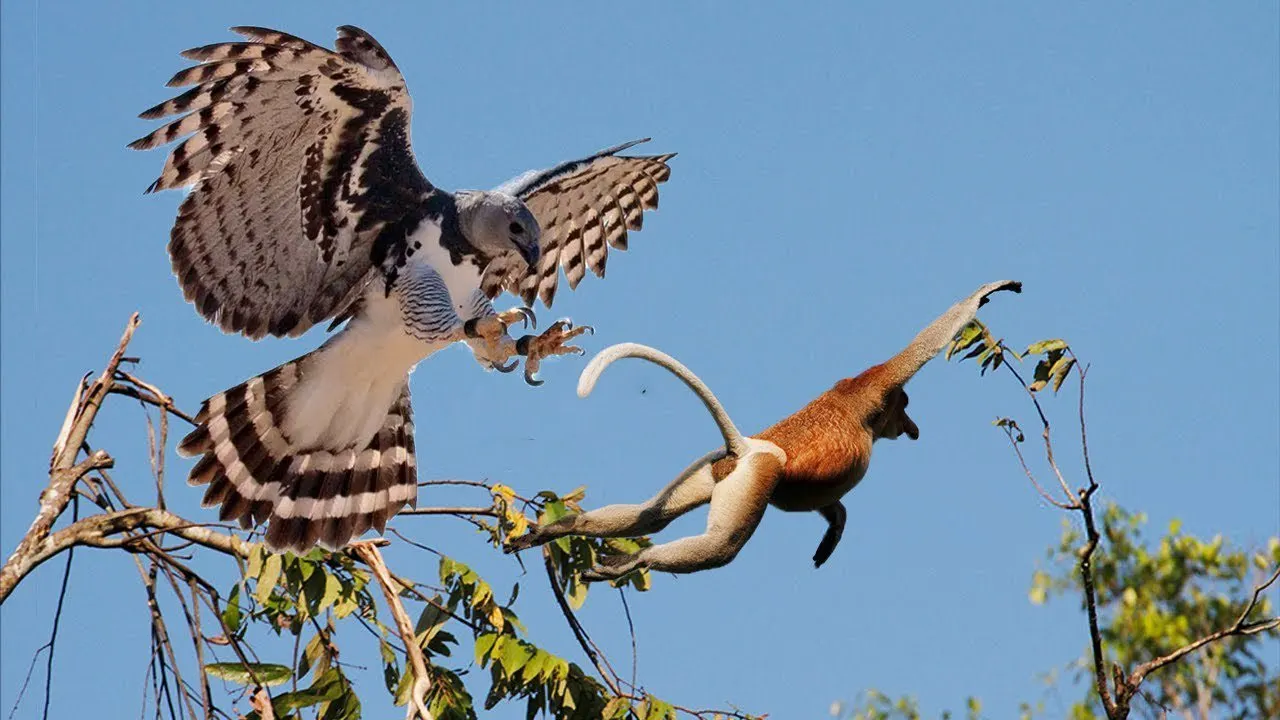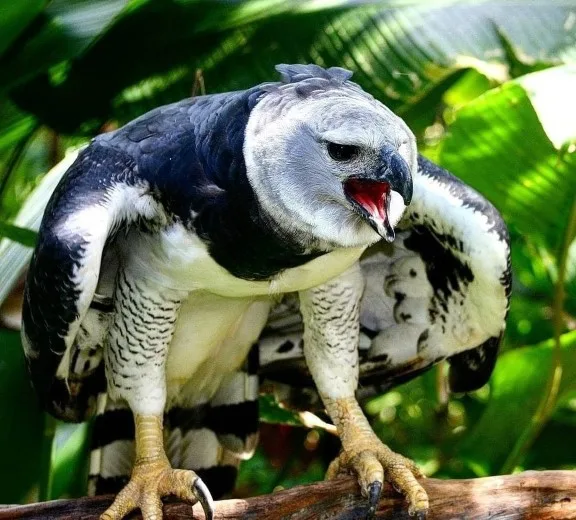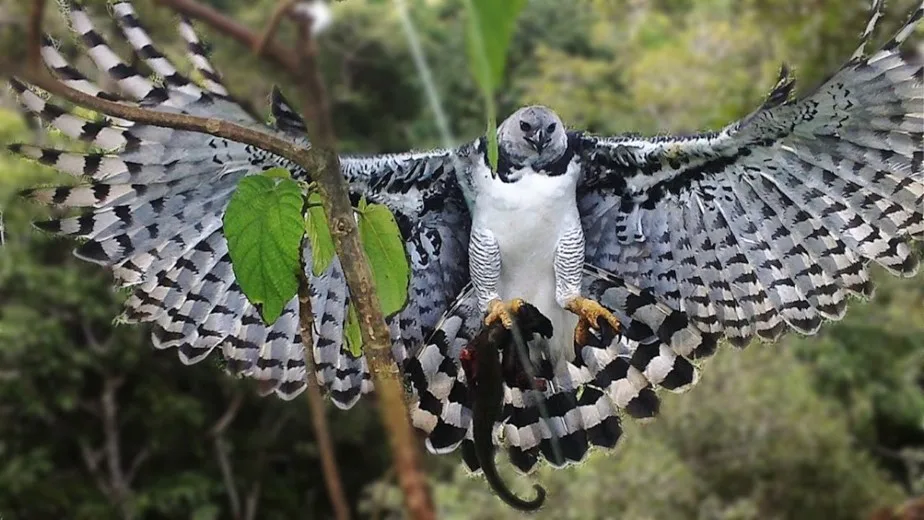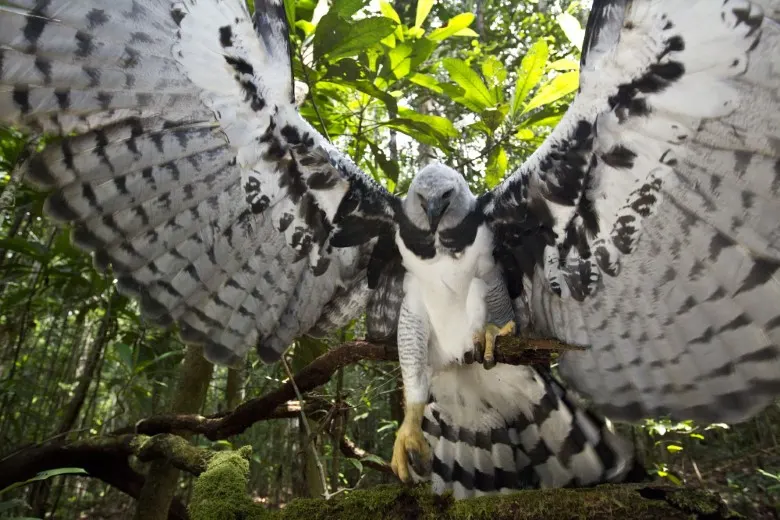Venturing into the Peruvian Amazon rainforest is a unique and fascinating experience that awakens all the senses. Among the most striking sounds is the powerful and deep call of the harpy eagle. This majestic bird of prey, recognized as the largest and strongest in the Americas, has captured the attention and admiration of explorers, scientists, and nature lovers around the world.
Below, we present in detail the features that make this impressive bird unique, its natural habitat in the dense tropical forests, and the best places in Peru where it is possible to observe it in complete freedom. You will learn why it is considered the “most powerful eagle in the world,” a title that reflects its strength, size, and top-predator skills at the top of the food chain.
What is the harpy eagle?

Name origin
The name harpy eagle (Harpia harpyja) comes from the harpies of Greek mythology, creatures with a human torso and the body of a bird of prey.
Scientific classification
The harpy eagle belongs to the family Accipitridae (diurnal raptors) and is the only species in the genus Harpia. Its classification is: Class Aves, Order Accipitriformes, Family Accipitridae, Genus Harpia, Species Harpia harpyja.
General characteristics
The harpy eagle is the largest and most powerful raptor in the Americas. Its plumage is grayish with black parts; on its head it has an erect crest of long feathers that gives it a formidable appearance. Females are even larger than males: they can measure up to 1.1 m (3.6 ft) tall, weigh between 7 and 9 kg (15–20 lbs), and reach a wingspan of up to 2 meters (6.5 ft). Its curved beak and huge talons (up to 12 cm / 4.7 in long) allow it to hunt prey like monkeys, sloths, and small deer. It is a solitary, territorial bird and an apex predator of the Amazonian canopy.
Where do harpy eagles live?
The harpy eagle lives exclusively in lowland tropical rainforests. Its distribution ranges from southern Mexico to northern Argentina. It prefers the tropical forests of the Amazon basin, such as those in Brazil, Peru, Colombia, Ecuador, Bolivia, and Venezuela. In Peru, it is found especially in the regions of Madre de Dios, Loreto, Cusco, and Junín. Its ideal habitat consists of large forests with emergent trees over 30 meters (98 ft) tall, where they can build nests and hunt with ease.

Impressions and facts about the harpy eagle
- An imposing bird of prey with thick legs and enormous talons (like human fists).
- So powerful it can slash and kill a giant sloth using only the strength of its feet.
- Forms lifelong pairs, and both parents participate in building the nest and raising their single chick.
- Cares for its young for up to 2 years after leaving the nest, far longer than other eagles.
- Has extremely sharp vision, capable of spotting small prey from a great distance.
- Emblematic in Amazonian countries: in Panama it’s a national symbol (appears on bills), and also appears on coins and bills in Venezuela.
- Feeds mainly on monkeys, sloths, porcupines, and other small birds. In Manu (Peru), its diet was mainly howler monkeys, porcupines, and sloths.
- Its front talons are comparable to those of a grizzly bear (up to 12 cm), capable of exerting over 50 kg (110 lbs) of pressure.
- There are only about 50,000 individuals in the wild, and its population is decreasing due to deforestation.
- Its nest, made of massive branches, can measure 1.2 m (4 ft) thick and 1.5 m (5 ft) in diameter, and is often reused year after year.

Harpy eagle adaptations and measurements
Adaptations
It has a facial disk that enhances its hearing, similar to owls. Its short, broad wings allow it to fly between trees in dense forest, and its square tail gives it flight stability. It is a stealthy hunter, launching surprise attacks from the canopy.
Measurements
- Males: 4 to 6 kg (8.8–13.2 lbs)
- Females: 7 to 9 kg (15.4–19.8 lbs)
- Body length: 0.86 to 1.1 m (2.8–3.6 ft)
- Wingspan: 1.8 to 2.24 m (5.9–7.3 ft)
- Front talons: up to 12 cm (4.7 in)

What time of day are harpy eagles most active?
The harpy eagle is a diurnal animal, meaning it is active during the day. Its most active hours are at dawn, when many prey animals descend from the canopy. Outside of hunting hours, it perches silently in tall treetops, observing its surroundings.
10 Curious facts about the harpy eagle
- Record size: It is the largest eagle species in the Western Hemisphere. Its body can reach 1.1 m (3.6 ft) and its wingspan up to 2 m (6.5 ft).
- Mythical name: Its name comes from the harpies of Greek mythology—mythical birds with the body of an eagle and the face of a woman.
- Ultra grip: Its front talons (up to 12 cm / 4.7 in) exert over 50 kg (110 lbs) of pressure, more than a brown bear. It can kill a sloth in one grip.
- Selective hunter: Feeds on large, tree-dwelling animals (monkeys, sloths, porcupines). In parts of Peru, its most common prey are howler monkeys, two-toed sloths, and porcupines.
- Ultra vision: Can detect small prey over 200 meters (656 ft) away thanks to its hawk-like vision.
- Slow life: Forms lifelong pairs, has a low reproductive rate (only one chick every 2–3 years), and cares for the young up to 2 years.
- Super nest: Builds huge nests with branches over 1 m (3.3 ft) thick at 27–43 m (89–141 ft) high. A single nest tree could shelter a human.
- Near-threatened species: Only about 50,000 remain, and it is listed as “Near Threatened” by the IUCN. Protected under international treaties banning its trade.
- National symbol: Appears on Panama’s coat of arms and currency and on Venezuelan banknotes as a national heritage bird.
- Elusive hunter: Very difficult to spot in the wild. Only local experts and specialized guides can find them from observation towers or by locating old nests in the Amazon.

Places in the world where you can see the Harpy Eagle in its natural state
- Amazon rainforest: Brazil, Peru, Colombia, Venezuela, Bolivia, and Ecuador.
- Central America: Panama (Darién National Park), Costa Rica.
- Mexico: in the Lacandon jungle (few individuals).
- Other countries: Suriname, French Guiana, and northern Argentina.

Reserves and National Parks in Peru where it is possible to see the Harpy Eagle in its natural state
- Manu National Park (Cusco and Madre de Dios): One of the most biodiverse places on the planet.
- Tambopata National Reserve (Madre de Dios): Primary rainforest accessible from Puerto Maldonado.
- Pacaya Samiria National Reserve (Loreto): Navigable by boat through flooded forests.
- Otishi National Park (Cusco and Junín): Remote and little explored, ideal for expeditions.
If you want the chance to see a harpy eagle in the wild, the excursions offered by Travel Peru Agency in these parks are an excellent option, always with guides specialized in observing Amazonian birds of prey.
Frequently Asked Questions About the Harpy Eagle

1. In which national parks in Peru can I observe a harpy eagle?
The best places are primary forests in Madre de Dios, Cusco, Loreto, and Junín. Highlights include Manu National Park, Tambopata National Reserve, Pacaya Samiria National Reserve, and Otishi National Park, where sightings are possible. It is recommended to travel with an expert guide who knows the nests and habits of this species.
2. What is its conservation status?
The harpy eagle is considered near threatened. The IUCN classifies it as Near Threatened due to the reduction of its forest habitat. There are few individuals left (~50,000) and its population is declining due to illegal logging. It is internationally protected under CITES Appendix I/II to prevent trade. In Peru, it lives within protected areas to ensure its survival.
3. What does the harpy eagle eat?
It is a top predator that hunts in the Amazonian canopy. Its diet includes mainly monkeys (howlers, titi), sloths, porcupines, and large birds. In Tambopata, for example, most of its diet consisted of porcupines, howler monkeys, and sloths. It can also catch large birds and other arboreal mammals up to 7–8 kg thanks to its powerful talons.
4. What is the best time to see the harpy eagle in the Peruvian Amazon?
The dry season (May to October) is ideal for birdwatching in places like Manu and Tambopata. There is less rain, trails are more accessible, and birds are more visible at dawn and dusk. During this time, special jungle excursions are organized, where, with patience and good luck, it is possible to see the harpy eagle flying over the canopy.

Venturing into the Peruvian Amazon rainforest allows you to encounter the harpy eagle, the most imposing and powerful bird of prey in the Americas. This bird, with a wingspan of up to 2 meters and talons that exert more than 50 kg of pressure, inhabits tropical forests of Peru, especially in Manu, Tambopata, and Otishi, where it can be seen with specialized guides. Contact us and book your adventure in the Peruvian Jungle where it is possible to see this powerful bird in its natural state.
